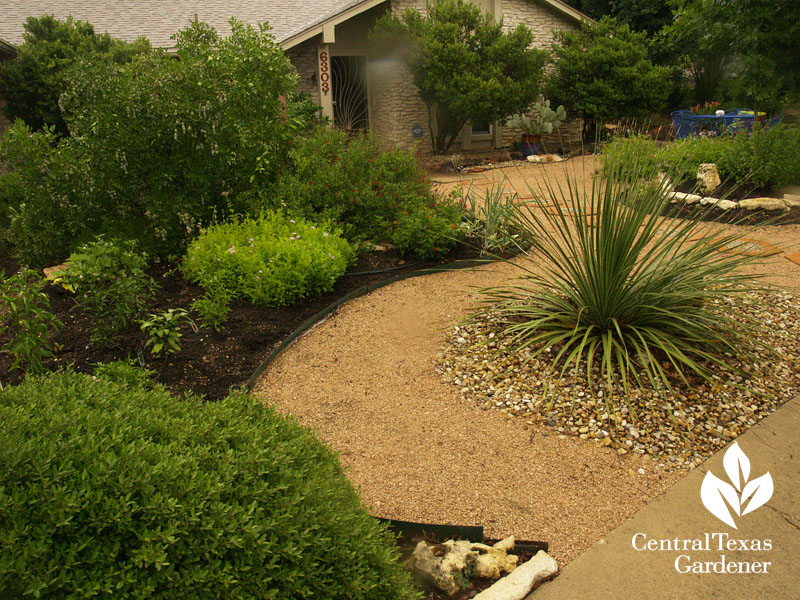October 11, 2012
On tour with the Travis County Master Gardeners
How can you reduce lawn, combine edibles, flowers for wildlife, living spaces, and art?

The best ideas come from fellow gardeners! That’s why you won’t want to miss the Travis County Master Gardeners’ “Inside Austin Gardens” tour on October 20. This year highlights hands-on gardeners who tuck in food with their salvias and succulents, like Ann & Robin Matthews, who even take it all out front.

They unite their garden with neighbor Donnis Doyle, also on tour.

In back, find out how they got rid of grass in favor of paths, coves, and a labyrinth-style vegetable garden.

See how they screen a view with Hardiboard imprinted with ancient Native American rock art they’ve seen on excursions throughout Texas.

On tour, you can also see how Donnis screened her view of a daycare center for a soothing spot to hang out with her neighbors.

Here’s a sneak preview with CTG’s video visit.
I love the natural screen the Matthews chose on one side: bay laurel!

Daphne makes bay laurel her Pick of the Week to explain how to grow this Central Texas evergreen as a screen or accent. Why buy expensive bay leaves when you can pluck some of your own?

When I got my bay laurel in a 4” pot, I potted it up as a patio container. It barely grew (though it’s fine in a pot if you have just a small space). Then, I ran into large bay hedges in long-term gardens. I saw Trisha’s huge one at her Lake Austin Spa garden. So, I stuck mine in the ground to shield a so-so shed. It shot up like a fiend in blasts of hot sunlight (not all day) and very little water. In 14°, it suffered a little leaf damage, but spring pruning flushed it right back out. The Barbados cherry in front died to the ground, but returned, too.

I just pluck a leaf when I need it for the pot. When I prune to tidy and shape, I bring in some to dry. If you missed Trisha’s segment on how to dry and anchor herbs, and the ones to choose, watch it now!
To preview the other gardens on tour, Tom meets with Travis County Master Gardeners Carolyn Williams and Holly Plotner.

Here’s just a tease of the diversity on tour this year!




Renee Studebaker isn’t officially a Master Gardener (though she’s a master at it!). If you’ve ever wanted a closer look at her garden, here’s the chance! She’s even going to be serving homemade treats from her harvests.

And find out where Daphne hangs out with a visit to the Texas AgriLife Extension Office demo gardens! She and Augie will be on hand (paw) all day to answer your questions!
Not only will you have a chance to talk with the gardeners to see how they did it and where they got it, each site includes educational talks and plant and book sales. All this for just $20 or $5 per garden, to support their many free workshops throughout the year. Find out more about upcoming workshops and details of the tour.
Since we all like to recycle, a viewer asks: “Can I spread used kitty litter on the grass or non-edible gardens?” Get Daphne’s answer about why this isn’t a good idea—it’s not what you might think. Telo and Camille Farber already watched this on their iCatfonz to pass along to their moms, sisters Galia (KLRU’s production coordinator) and Naomi.

In the next few weeks, it’s time to plant wildflower seeds like Indian blanket (Gaillardia pulchella).

Andrea DeLong-Amaya from the Lady Bird Johnson Wildflower Center shows how to sow for the best success. Since bluebonnets are tops on the list, she explains how to improve germination the first year.

Note: the inoculant she mentions has become very hard to find, so go with one of her other techniques to start your bluebonnet patch. Trisha sometimes moves bluebonnet plants to a new area (or you can buy transplants) to inoculate the soil, too. I’ve always had great luck without the inoculant.
Happy planting until next week! Linda
tags:

